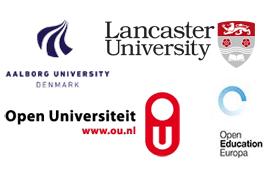

Visualising structure and agency in a MOOC using the Footprints of Emergence framework
Jenny Mackness, Independent Education Consultant and Researcher, Jutta Pauschenwein, Head of ZML-Innovative Learning Scenarios, FH JOANNEUM
Reviews of research into MOOCs have identified two areas needing further research; the individual learner experience and the role of the teacher/facilitator. In this paper we examine the teacher/facilitator’s role as MOOC designer in achieving an appropriate balance between structure and agency in the design of a specific MOOC, and consider whether this balance was achieved by analysing the learners' experience of this MOOC. To do this we used a tool known as Footprints of Emergence, which enables designers, teachers, learners and researchers to visualise the course design and their learning experience in any course. Drawing Footprints of Emergence requires deep reflection on 25 factors which influence learning in complex learning environments, such as MOOCs.
The context for this research was the Competences for Global Collaboration MOOC (cope15) offered by FH Joanneum, in Graz, Austria, in Spring 2015. Through negotiation and taking advantage of a diversity of competences and experiences, the team designed a hybrid learning space with a multitude of resources and learning paths. They used an approach which combined Salmon's model for moderating small groups of learners with the principles of connectivism and the structuring of xMOOCs. In using this approach the teachers needed to adopt unfamiliar roles as open practitioners and relinquish control over their students. The visualisation offered by the design footprint of cope15 helped to frame their discussion and planning.
The MOOC design required learners to assume responsibility for their own learning, deal with uncertainty and be open to a holistic learning experience. At the end of the MOOC they were asked to draw a Footprint to reflect on their learning experience and provide a written reflection. 30 participants agreed to their Footprints and written reflections being analysed for this research. The Footprints show that a balance between structure and agency was achieved for these learners. They experienced neither too much prescription nor too much chaos in the MOOC design and learning processes. These preliminary findings suggest that attention to structure and agency using the Footprints of Emergence visualisation tool enables the design of a MOOC to meet learners’ needs, and supports end of course reflection and evaluation.
Keywords
Footprints of Emergence, MOOC, Structure, Agency, Emergent Learning
Joint Organising Institutions
| Conference Travel and Accommodation |Doctoral Consortium | Past Conference Proceedings | Contact |